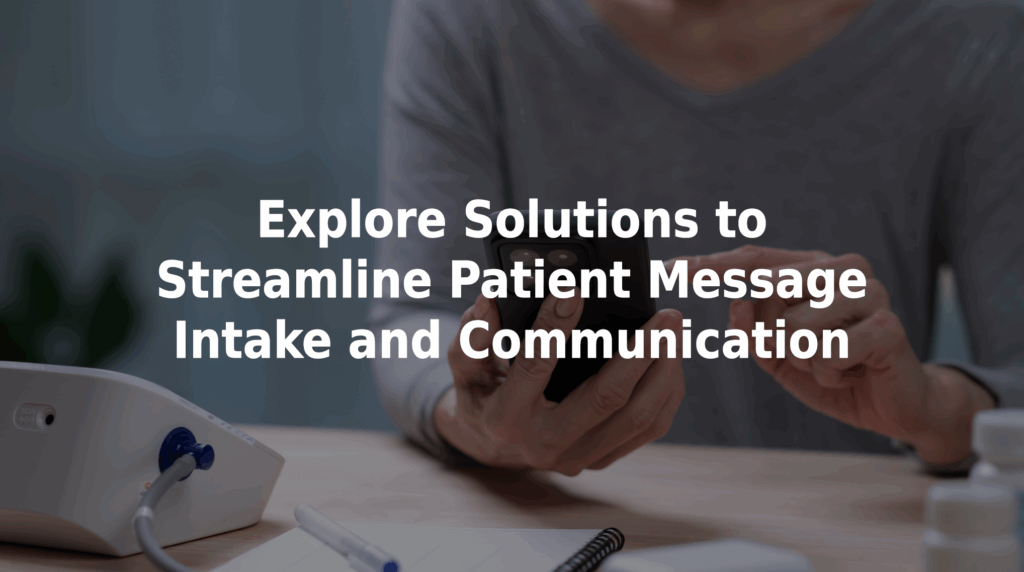Explore Solutions to Streamline Patient Message Intake and Communication
Disjointed medical intake can lead to delays in care, frustrated patients, and increased staff workloads. That’s why clinical operations managers are turning to automated solutions that can improve patient message intake and communication through greater accuracy and efficiency.
Below, we’ve compiled expert insights and best practices to help your team determine which automation is best for their needs, and how TriageLogic’s MedMessage Automate can fit within that strategy.
1. Common Challenges for Medical Message Intake
Explore the main issues that nonclinical operators face with patient requests, and how these can affect health outcomes.
Read About the Issues
2. How Inaccurate Messages Affect Clinical Outcomes
Understand how message errors can lead to delayed care, misdiagnoses, and poor patient satisfaction — and how you can avoid them.
See the Effects
3. How Automation Simplifies Patient Requests
Learn how automated intake can reduce wait times, improve the accuracy of reported symptoms, and empower patients to communicate more effectively.
Explore the Benefits
4. Explore the Benefits of AI Message Intake
AI can help your team standardize intake, support triage decisions, and scale operations without compromising care.
See What It Can Do
5. Manual vs. Automated: Which Patient Intake Is Better?
Unfortunately, manual message intake can be prone to errors and inaccuracy. We explore how automation can avoid them so that patients receive accurate, timely care.
Check Out the Comparison
6. Smarter Intake Leads to Fewer Call Handling Errors
Nonclinical operators are not certified medical professionals, which means they can overlook key questions that should be asked to clarify certain symptoms. Learn how automation reduces this burden.
Read About Our Solution
7. Automating Intake: Best Practices for Clinical Teams
Learn about steps you should take prior to selecting and implementing automation that will offer the most success.
Make Your Plan
8. How Automated Patient Intake Saves Revenue
Uncover how automation can streamline symptom reporting, avoid costly delays in care, and generate ROI through smarter workflows.
Explore Savings
9. Case Study: Hospital Reduces Hold Times With Automated Intake
Learn how a hospital system used automated intake to manage its high call volume, develop more accurate intake, and improve patient satisfaction.
Access the Full Story
10. How to Fully Utilize Automated Intake
Learn how system integration, workflows, staff training, and performance metrics all play a part in understanding the effectiveness of your intake.
Get the Breakdown
11. Training Tips for Staff on Automated Intake
From onboarding to continuous support, here are the techniques we recommend for successful adoption.
Empower Your Team
12. Automated Intake Can Integrate With Your EHR
When data exists in silos, it’s easy for it to be incomplete or inaccurate. Read why the ability to integrate intake automation with your EHR is so important to clinical response times and continuity of care.
See the Difference
13. Clinical Success Stories That Highlight the Value of Automated Intake
Besides the hospital case study above, plenty of healthcare organizations can benefit from our automated intake solution. Here are some of those examples.
Read How MedMessage Assist Can Help
14. Improve Patient Satisfaction With Self-Reporting Intake
By allowing patients to self-report their symptoms through complete and accurate intake, automation has been shown to improve clinical response times and boost patient satisfaction and trust.
Improve Your Patient Experience
15. Why You Should Advocate for Automated Intake
Learn how you can build support across departments to adopt automated intake, and how it can benefit your overall operations.
Read About Intake Advocacy
Explore the Full Capabilities of MedMessage Automate
TriageLogic’s MedMessage Automate is a proven AI-powered solution designed to enhance patient message intake and communication. It’s compliant with HIPAA, able to integrate with your in-house software, and has been shown to save 3-7 minutes per patient to expedite their requests.
Contact us today to learn more about it and schedule a demo!


